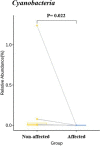Can medication-related osteonecrosis of the jaw be attributed to specific microorganisms through oral microbiota analyses? A preliminary study
- PMID: 38302952
- PMCID: PMC10832156
- DOI: 10.1186/s12903-024-03945-z
Can medication-related osteonecrosis of the jaw be attributed to specific microorganisms through oral microbiota analyses? A preliminary study
Abstract
Background: Medication-related osteonecrosis of the jaw (MRONJ) can cause significant pain and loss of aesthetics and function if not treated properly. However, diagnosis still relies on detailed intraoral examinations and imaging. Prognosis varies even among patients with similar stages or conditions of MRONJ, emphasizing the need for a deeper understanding of its complex mechanisms. Thus, this study aimed to identify the oral microbiota of patients with MRONJ.
Methods: This single-center prospective cohort study included patients with confirmed MRONJ who visited the Department of Oral and Maxillofacial Surgery at Yonsei University Dental Hospital between 2021 and 2022. Oral swab samples were collected from the affected and unaffected sides of each patient. The composition and enumeration of the microbial communities were analyzed, and the diversity was compared to verify ecological changes in the groups using a next-generation sequencing-based 16S metagenomic analysis. A statistical analysis was performed using Wilcoxon signed-rank test with SPSS version 22, and values of P less than 0.05 were considered statistically significant.
Results: The final study sample included 12 patients. The mean age was 82.67 ± 5.73 (range, 72-90) years. Changes in microbial composition were observed at different taxonomic levels (phylum, genus, and species). The identified microorganisms were commonly associated with periodontitis, gingival disease, and endodontic infection, suggesting a multifactorial etiology of MRONJ.
Conclusions: Although this study is based on a small number of cases, it shows that MRONJ is not caused by a specific microorganism but can rather be caused by a variety of factors. By addressing these findings in large-scale studies, the significance of oral microbiome in pathogenesis can be further elucidated and can facilitate the development of effective therapeutic interventions for patients with MRONJ.
Keywords: Medication-related osteonecrosis of the jaw; Metagenomics; Microbiome; Oral bacteria.
© 2024. The Author(s).
Conflict of interest statement
The authors declare no competing interests.
Figures







References
MeSH terms
Substances
LinkOut - more resources
Full Text Sources

